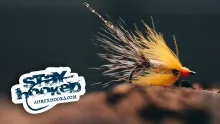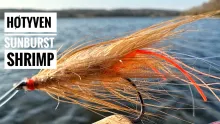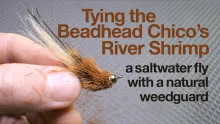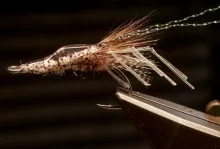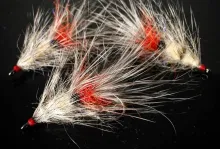A shrimp pattern can be either a caricature or an imitation. The Slinky Shrimp falls somewhere in between
I have a confession to make. I’m a bit obsessed with tying shrimps. There something about their simplicity coupled with their effectiveness that keeps me devising new methods for imitating the little critters. There’s lots of scope, a shrimp pattern can be either a caricature or an imitation. I’m not sure hungry fish care either way, so you can go simple or complex, easy or hard, whatever takes your fancy.
At its simplest tying a shrimp can be just a matter of dubbing a hook and then pulling a material over the top to represent the shell back. A rib may be added to segment the shell and hold it in place and modern UV-resins give a lot of scope for building simple or complex shells.
My book Fly Couture contains a number of different shrimp designs using natural and synthetic materials.
The Slinky Shrimp is tied using a pre-prepared shell formed by winding vinyl body glass and tinsel over hollow braid held on a sewing needle. The process is a variation of the technique I use to tie the body for my Skin & Foam Pupa and Stealth Stonefly.
Tying the shrimp this way creates a segmented translucent shell just like the real thing. It also removes the hassle of winding a wire or monofilament rib through the underlying legs without trapping them, something that I find can be a bit of a pain to do.
When you tie the shell make it about one centimetre longer than required for the back of the shrimp on your chosen hook size. This will allow you to tie it in and cut off the front end in front of the hook eye, unravel the braid and the two ends of body glass and then trim them individually so you can finish with a neat head.
Nick Thomas
Body glass comes in a wide range of colours so you can tie variants in natural shades, or you can use the pink, orange or red stuff to tie up bright blingy ones for winter grayling. Having said that I generally find that they are just a happy as trout to take a natural looking shrimp.
- Log in to post comments






